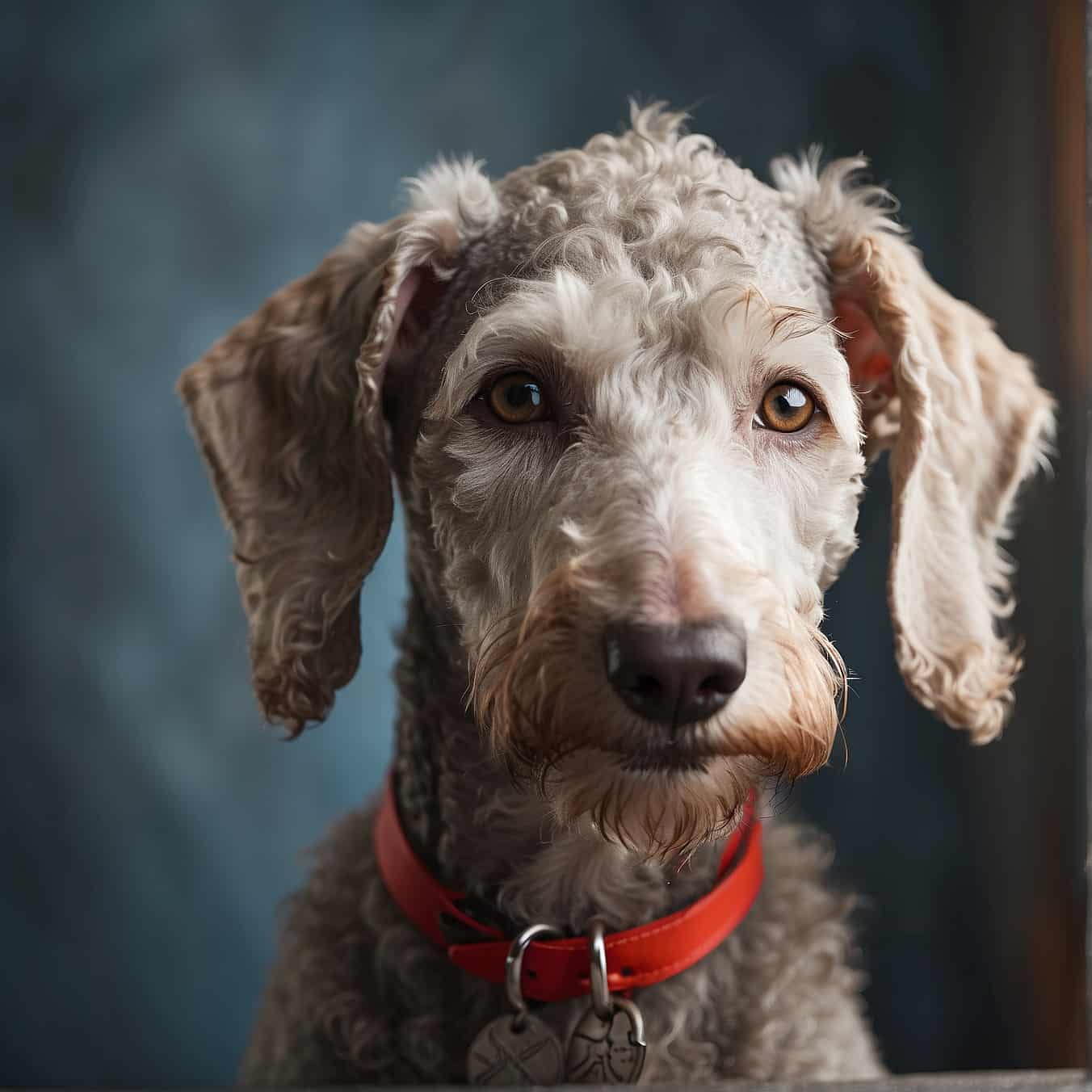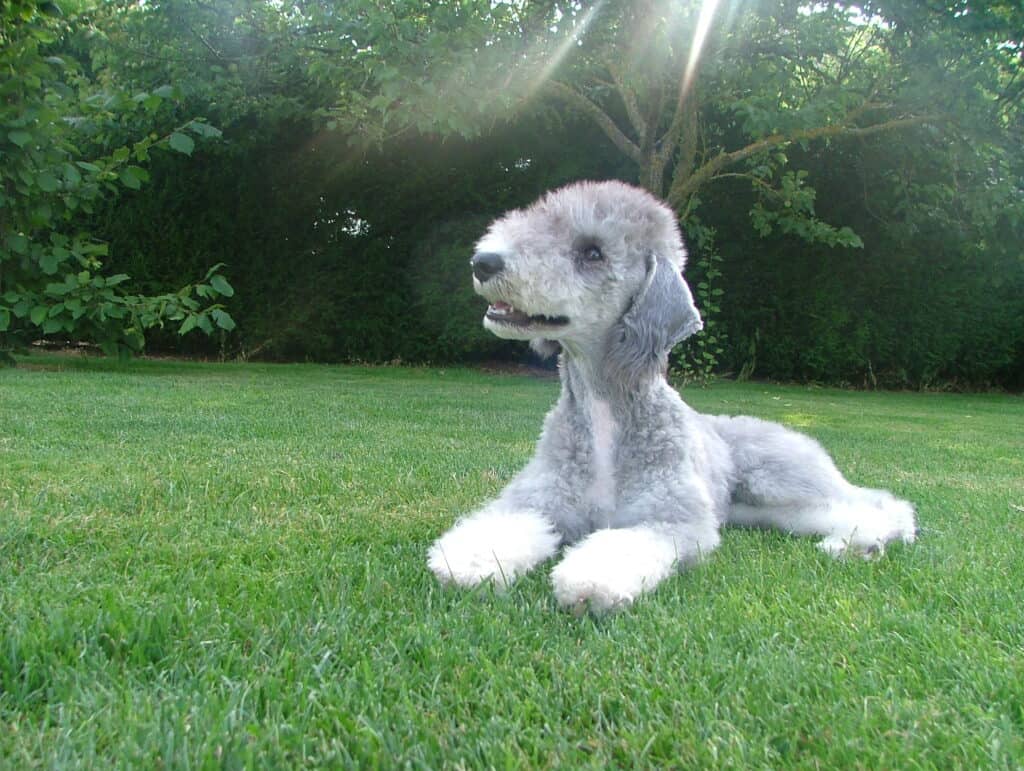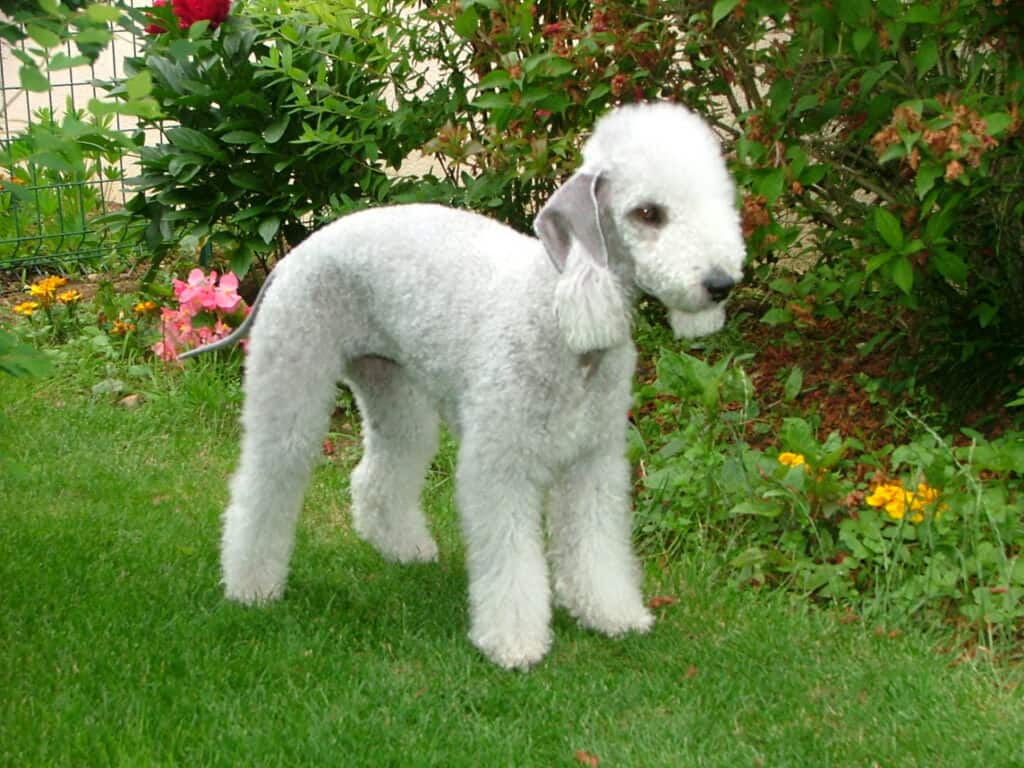Bedlington Terriers have a unique and distinctive appearance. Delve into their history, learn about the care they deserve, and discover the gentle and affectionate nature that sets Bedlingtons apart.

| Category (Explanation) | Breed Information |
|---|---|
| Year of Breed Conception | 18th century |
| Country of Origin | England |
| Weight (lbs & kg) (Male) | 17-23 lbs (8-10.5 kg) |
| Weight (lbs & kg) (Female) | 17-23 lbs (8-10.5 kg) |
| Coat Type | Dense, curly coat |
| Color Variations | Blue, liver, sandy |
| Shedding Level (Low, Moderate, High) | Low to Moderate |
| Height (cm & in) | 16-17 inches (40-43 cm) |
| Breed Size | Small to medium |
| Trainability (Low, Moderate, High) | Moderate |
| Mental Needs (Low, Moderate, High) | Moderate |
| Intelligence Level (Low, Moderate, High) | Moderate |
| Energy Level (Low, Moderate, High) | Moderate |
| Agility (Low, Moderate, High) | Moderate |
| Loyalty (Low, Moderate, High) | High |
| Playfulness (Low, Moderate, High) | Moderate |
| Exercise Needs | Regular exercise and playtime |
| Guarding Proficiency (Low, Moderate, High) | Low |
| Sociability with Children (Low, Moderate, High) | High |
| Barking Level (Low, Moderate, High) | Low |
| Digging Tendency (Low, Moderate, High) | Low |
| Destructive Behavior (Low, Moderate, High) | Low |
| Drooling Level (Low, Moderate, High) | Low |
| Obedience Level (Low, Moderate, High) | Moderate |
| Apartment Friendly (Yes/No) | Yes, with sufficient exercise |
| Inherent Prey Drive | Moderate |
| Physical Risk to Others (Low, Moderate, High) | Low |
| Travel Fatality Risk (Low, Moderate, High) | Low |
| Allergen Potential | Low |
| Health Concerns (List of Common Health Concerns) | Copper Toxicosis, Eye Issues |
| Average Life Expectancy (Life Expectancy in Years) | 12-16 years |
Woof Mastery is reader supported and our articles may contain affiliate links.
Instead of running third party ads that we have no control of we only use links from high-quality companies we are directly partnered with. Making use of these links come at no cost to you our reader, and in many cases have the extra benefit of discounted rates or sign up bonuses.
If you’re interested you can read more about our affiliate policy here.
We appreciate your support and always insure that the products and services we recommend are high-quality, helpful and relevant to the subject at hand!
Bedlington Terriers have a unique and distinctive appearance. Originating in England, they were initially known as Rothbury Terriers and were used for hunting. Their gentle and affectionate nature made them popular pets over time. Their history as hunting dogs has transitioned into their modern role as beloved family pets. Today, Bedlington Terriers are known for their unique appearance and the endearing and affectionate traits that set them apart as cherished companions.

Bedlington Terriers have a unique and distinctive appearance. What makes them special is their unique appearance, gentle disposition, and affectionate nature. Delve into their history, learn about the care they deserve, and discover what sets Bedlingtons apart. Bedlington Terriers are special for their gentle and affectionate personality, adding a touch of elegance to the lives of those who choose them as companions.
Bedlington Terriers have a traditional role closely tied to their unique appearance and gentle nature. Originating in Bedlington, Northumberland, England, these dogs were originally bred for hunting game, including rabbits and hares. Their distinctive appearance allowed them to blend in with their prey. Their gentle and affectionate personality made them excellent companions. While their hunting role has evolved, Bedlington Terriers continue to display their unique and endearing traits as beloved family pets, preserving their heritage as skilled hunters and devoted companions.
Bedlington Terriers have a unique and distinctive appearance. They are characterized by their gentle and affectionate nature. These terriers can be loving and make great family pets. They are known for their distinctive appearance and require training and socialization to ensure they are well-behaved and endearing companions.
Bedlington Terriers have a unique and distinctive appearance. They are typically gentle and affectionate dogs. Their loving nature makes them great companions. However, they may exhibit stubbornness at times. Training and socialization are crucial to prevent any behavioral challenges. Their adaptability and unique appearance make them stand out among terrier breeds.
Bedlington Terriers have a unique and distinctive appearance, with a dense, curly coat that can come in various colors, including blue, liver, or sandy. They have a well-proportioned, lamb-like appearance, with a rounded skull, arched back, and a distinctive topknot. Bedlingtons have expressive dark eyes and small, triangular ears. They have a graceful and affectionate gait, reflecting their gentle and charming nature.
Bedlington Terriers have a unique coat that is typically blue, liver (a reddish-brown), or sandy in color. Their coat is soft and curly, which contributes to their distinct appearance. The coat color variation adds to their elegance and charm.
Bedlington Terriers have a distinctive and unique coat that is typically a solid color, including blue, liver, or sandy. Their appearance is elegant and often likened to that of a lamb.
Bedlington Terriers have a low shedding level. They have a unique, curly coat that requires regular grooming to prevent matting and maintain its texture. Regular brushing and occasional grooming sessions can help manage shedding and keep their coat healthy. While they shed minimally, attention to their coat’s specific needs contributes to reduced shedding. Overall, Bedlington Terriers are considered to be a breed with low maintenance in terms of shedding.
Bedlington Terriers have a distinctive curly coat that requires regular grooming. Grooming habits for Bedlington Terriers include:
Bedlington Terriers have a moderate to high activity level. While they have a distinctive appearance, these terriers are agile and enjoy various activities. Daily walks, playtime, and interactive games are important for their physical and mental well-being. Bedlington Terriers may also participate in dog sports like agility. While not overly hyperactive, they benefit from regular exercise to prevent boredom. As they have a unique coat that requires grooming, incorporating regular grooming sessions into their routine is also essential for their overall care.
Bedlington Terriers are intelligent and trainable dogs. They are known for their agility and ability to learn a variety of commands. Positive reinforcement methods work well with Bedlington Terriers, and they thrive in environments where they receive mental stimulation. Their intelligence, combined with an affectionate nature, makes them well-suited for activities such as obedience training and agility. Bedlington Terriers are quick learners and enjoy engaging with their owners in play and training sessions.
Bedlington Terriers have moderate mental needs. Keep them mentally stimulated with activities such as puzzle toys, interactive games, and obedience training. Regular social interaction is important, as they thrive on companionship and attention. Provide a variety of toys and activities to prevent boredom, and consider engaging them in dog sports or activities that tap into their intelligence.
Enter The Woof Mastery

Prospective owners of Bedlington Terriers should be aware of their unique characteristics and care requirements. These dogs are known for their distinctive appearance, intelligence, and gentle nature. Regular grooming is essential to maintain their coat, and potential owners should be prepared for this commitment. Bedlingtons thrive in a loving and active environment, requiring both mental and physical stimulation. Early training and socialization contribute to their well-rounded behavior. Responsible ownership includes meeting their grooming needs and providing a safe, affectionate home for these loyal and charming companions.
Bedlington Terriers, known for their gentle and friendly demeanor, pose a low risk to others. Proper socialization and training are important to reinforce their positive behavior. Responsible ownership, understanding individual temperament, and adherence to local regulations contribute to a positive experience with this breed.
Bedlington Terriers can be gentle and affectionate, making them suitable for families with children. Supervision is essential during play, and teaching children how to interact respectfully with the dog is important. Positive socialization experiences contribute to a well-balanced relationship.
Bedlington Terriers may have varying responses to water. Some individuals may enjoy swimming, while others may not be as comfortable. Introduce them to water gradually and observe their comfort level. Always prioritize safety, and use a canine life vest if needed, especially in situations where they may be at risk of fatigue.
Remember that Bedlington Terrier puppies, like all puppies, are eager to please and learn. Positive and consistent training practices will help them become well-behaved, obedient, and happy adult dogs. Building a strong and trusting bond with your puppy through training is a rewarding experience for both you and your canine companion.
Bedlington Terriers are not typically considered noisy. They may bark to alert their owners or express themselves, but excessive barking is not a common trait. Proper training and socialization contribute to a well-mannered and appropriately vocal Bedlington Terrier.
Bedlington Terriers can adapt to different living conditions. They do well in homes with yards where they can play, but they can also adapt to apartment living if exercised regularly. Bedlingtons enjoy socializing with their family and are known for their affectionate nature. Regular grooming is necessary to maintain their unique coat. They thrive in environments where they receive attention and mental stimulation.
When traveling with Bedlington Terriers, consider their size and energy level. Secure them in the vehicle using a crate or a seatbelt harness suitable for their size. Monitor for signs of stress or anxiety, and provide familiar items for comfort. Plan for breaks to allow them to stretch and exercise. Positive reinforcement can help create positive associations with travel for Bedlington Terriers.
Bedlington Terriers may be prone to specific health concerns. While not all individuals will experience these issues, it’s essential for Bedlington Terrier owners to be aware of potential health problems and work with veterinarians to maintain their pets’ well-being. Common health concerns in Bedlington Terriers include:
Regular veterinary check-ups, a balanced diet, proper exercise, and responsible breeding practices can contribute to the overall well-being of Bedlington Terriers. Owners should collaborate with veterinarians to address any health concerns promptly.
Proper nutrition is crucial for the health and well-being of Bedlington Terriers. Here are some nutritional habits and best practices to consider for this breed:
Breed-Specific Laws (BSL): Bedlington Terriers may be subject to breed-specific laws (BSL) in certain areas. These laws are often enacted at the local or municipal level and can vary widely from one jurisdiction to another.
Types of Restrictions: The specific restrictions imposed on Bedlington Terriers under BSL can include mandatory spaying/neutering, special licensing, liability insurance requirements, muzzling in public, and, in some cases, bans on ownership. The severity of these restrictions depends on local regulations.
Rationale for BSL: BSL is typically implemented based on concerns about public safety and perceived risks associated with specific breeds, often due to incidents involving dog attacks. While Bedlington Terriers are not inherently aggressive, they can be affected by BSL due to their physical resemblance to breeds that are sometimes included in these laws.
Controversy: It’s important to note that BSL is a controversial topic. Critics argue that it unfairly targets breeds rather than addressing individual dog behavior and that responsible ownership and training should be emphasized instead of breed-specific restrictions.
Local Regulations: To determine if there are breed-specific laws or restrictions regarding Bedlington Terriers in your area, you should check with your local animal control or government authorities. Be aware of and comply with any local regulations to ensure that you are in compliance with the law while owning a Bedlington Terrier.
Woof Mastery is reader supported and our articles may contain affiliate links.
Instead of running third party ads that we have no control of we only use links from high-quality companies we are directly partnered with. Making use of these links come at no cost to you our reader, and in many cases have the extra benefit of discounted rates or sign up bonuses.
If you’re interested you can read more about our affiliate policy here.
We appreciate your support and always insure that the products and services we recommend are high-quality, helpful and relevant to the subject at hand!
Myth 1: Bedlington Terriers are too high-maintenance.
Myth 2: They are not good with other pets.
Myth 3: They are not suitable for families.
Myth 4: They are not intelligent.
Myth 5: They are too small to be active.
Famous Bedlington Terrier examples are not as widely documented, but these dogs, known for their distinctive appearance and gentle nature, can be found in the homes of devoted owners who appreciate their unique qualities.
The Bedlington Terrier carries cultural significance in various aspects:
The Bedlington Terrier, known for its distinctive appearance, does not have a single most famous historical owner. However, Bedlington Terriers have been owned by dog enthusiasts who appreciate their unique coat and friendly demeanor.
Bedlington Terriers, like many breeds, have faced challenges over the years. Some notable challenges include:
The Bedlington Terrier is a unique-looking terrier breed that originated in England. It is believed to have been developed from a combination of terrier breeds, including:
Bedlington Terriers, with their distinctive appearance and gentle nature, make delightful family companions. Known for their loyalty and sociable demeanor, they form strong bonds with their owners. Their hypoallergenic coat and minimal shedding make them suitable for families with allergies. Bedlington Terriers thrive on companionship and engage actively in play. Their adaptability to different environments and their friendly disposition make them cherished members of the household.